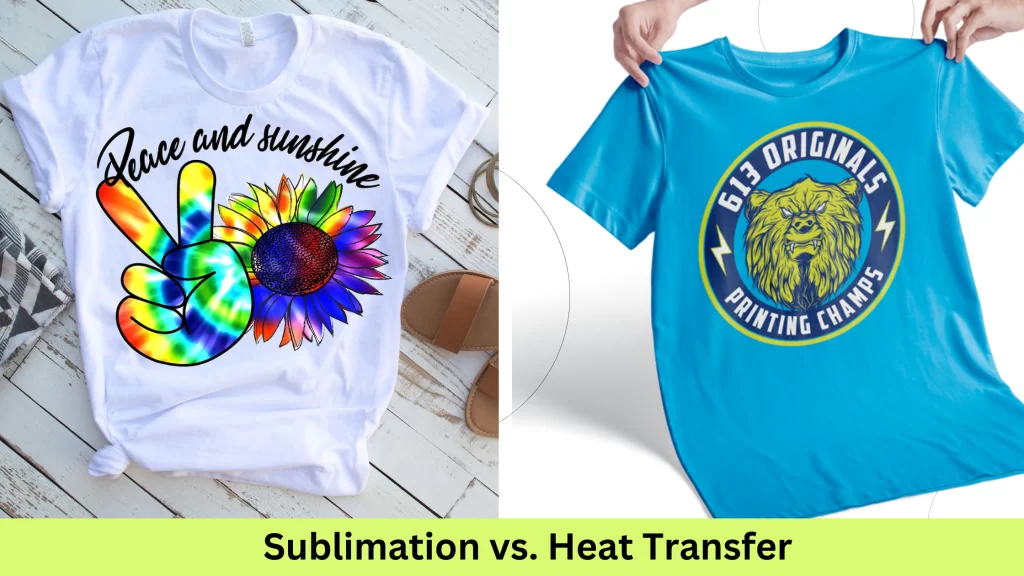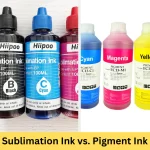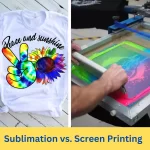Choosing the right printing method for t-shirts can make or break the quality and longevity of your designs. When comparing sublimation vs. heat transfer (two popular techniques), it’s essential to understand their impact on achieving exceptional results.
In a nutshell, sublimation involves transforming ink into a gas, and bonding it with fabric fibers for vibrant and long-lasting prints. On the other hand, heat transfer relies on heat and pressure to stick designs onto the fabric surface, offering versatility but potentially sacrificing durability.
As a t-shirt printing expert, I’ve tried both methods and found that sublimation better for creating vibrant and durable designs on fabric. To make an informed decision, let’s compare both!
Also read about sublimation paper vs. heat transfer paper.
Contents
Comparison between Sublimation vs. Heat Transfer
Both methods offer distinct approaches to achieve eye-catching designs on various surfaces, but they differ significantly in terms of process, results, and suitability for different applications.
Both have their own advantages and disadvantages, so it’s important to compare them before deciding which one is right for you.
Sublimation Printing
Sublimation printing is a process that uses heat to transfer sublimation dye onto fabric. The dye is in a solid state when it is printed onto a special type of paper, but when it is heated, it changes to a gas and then penetrates the fabric.
One of the best things about sublimation printing is that it allows you to print complex designs and gradients with seamless results. This is because the dye is actually absorbed into the fabric, rather than being applied to the surface.
This makes sublimation printing ideal for printing high-quality images and photos on t-shirts, mugs, tumbler, vinyl, and other items.
However, there are a few downsides to sublimation printing:
- It is only possible to sublimate onto light-colored polyester or polymer-coated fabrics, this method is not best suited for dark-colored and 100% cotton fabric.
- Sublimation printing requires specialized equipment and sublimation inks. This can make it more expensive than other printing methods, such as heat transfer printing.
Read how to wash sublimation shirts properly.
Heat Transfer Printing
Heat transfer printing is a process that uses heat and pressure to transfer a design from a transfer sheet to a fabric. When the transfer sheet is placed on the fabric and heated, the ink melts and transfers to the fabric, making a layer on the fabric’s surface.
Heat transfer printing offers remarkable versatility, allowing you to print on various fabric types and colors. Whether it’s cotton, polyester, or blends, heat transfer can adhere to different materials, expanding your creative possibilities.
Moreover, there is a wide range of heat transfer materials available, offering unique effects such as glitter, metallic, or even glow-in-the-dark finishes.
However, heat transfer printing does have some limitations:
- The ink can crack, peel, or fade over time, and it is not as durable as sublimation printing.
- Heat transfer printing is not as good at achieving complex designs or intricate details.
Comparing Sublimation and Heat Transfer for T-Shirts
Here is a concise comparison of sublimation and heat transfer printing for t-shirts:
1. Print Quality and Durability
When it comes to print quality and durability, both sublimation and heat transfer methods have their merits.
Sublimation printing offers vibrant colors, sharp details, and excellent wash and fade resistance, ensuring your designs stay bold and intact for a long time. It also maintains the breathability and comfort of the t-shirt fabric.
On the other hand, heat transfer printing can produce high-quality prints, but they may be slightly less vibrant and can be prone to cracking, peeling, or fading over time.
2. Design Flexibility and Complexity
In terms of design flexibility and complexity, sublimation printing takes the lead. It allows for full-color prints, multi-layered designs, and even photo-realistic artwork.
Heat transfer printing, while versatile, may face limitations in achieving complex designs due to its transfer method.
3. Material Compatibility and Versatility
Sublimation printing works best on light-colored polyester or polymer-coated t-shirts. It bonds with the fabric, ensuring vibrant prints.
Heat transfer printing, on the other hand, is more versatile and can be applied to various fabric types, including cotton, polyester, and blends. It also offers options for dark-colored or non-polyester T-shirts.
4. Color Vibrancy and Range
In terms of color vibrancy and range, sublimation printing tends to offer a wider spectrum. It allows for unlimited colors and smooth gradients, ensuring eye-catching designs.
Heat transfer printing, while it can produce vibrant prints, may have a slightly more limited color range compared to sublimation.
Here’s a comparison table between sublimation vs. heat transfer:
| Feature | Sublimation | Heat Transfer |
| Print quality | Highest | Lower |
| Durability | Very durable | Less durable |
| Design flexibility | Most versatile | Less versatile |
| Material compatibility | Light-colored polyester fabrics only | Wider range of fabrics, including dark-colored fabrics and fabrics that are not made of polyester |
| Color vibrancy | Most vibrant | Less vibrant |
| Color range | Wider range of colors | More limited range of colors |
| Cost | More expensive | Less expensive |
| Setup cost | Higher | Lower |
| Running cost | Higher | Lower |
| Complexity | More complex | Less complex |
| Skill level required | Higher skill level required | Lower skill level required |
| Setup time | More time-consuming | Less time-consuming |
| Maintenance | More complex | Less complex |
Choosing the Best Method for Your T-Shirt Printing Needs
As we have seen that both sublimation and heat transfer offer unique advantages, but understanding their differences will help you make an informed decision.
In my experience, sublimation printing has been a better choice for t-shirt printing. The colors are bold, the details are sharp, and the prints stay vibrant even after multiple washes. It’s perfect for light-colored polyester or polymer-coated t-shirts.
On the other hand, heat transfer printing has its own merits. It offers versatility in terms of fabric compatibility, allowing you to print on a wide range of materials, including cotton, polyester, and blends. The customization options are endless, and it’s relatively easier to incorporate personalized touches.
However, it’s important to note that the durability and longevity of heat transfer prints may vary depending on factors like material and care.
Conclusion
In conclusion, the debate between sublimation and heat transfer for t-shirt printing comes down to understanding the unique characteristics and considering your specific needs.
Sublimation printing offers vibrant and long-lasting prints with unlimited color options, making it ideal for light-colored polyester t-shirts. It excels in printing complex designs and gradients seamlessly, but requires specialized equipment and sublimation-compatible inks.
On the other hand, heat transfer printing provides versatility, allowing you to print on various fabric types and colors. It offers customization options and a wide range of effects but may face challenges with long-term durability, such as cracking, peeling, or fading.
To determine the best method for your t-shirt and mug projects, carefully assess factors like print quality, design flexibility, material compatibility, and color vibrancy. Consider your desired outcomes, material preferences, and budget constraints.
Frequently Asked Questions
Is heat transfer sublimation?
No, heat transfer is not the same as sublimation. Heat transfer covers various methods of transferring designs onto fabric using heat, including sublimation, but it also includes other techniques such as vinyl and plastisol transfers.
Is sublimation different from heat press?
Yes, sublimation is different from a heat press. Sublimation refers to the process of converting dye from a solid to a gas, which then bonds with polyester fibers. A heat press, on the other hand, is a machine used to apply heat and pressure to transfer designs onto various surfaces, including fabric.
In sublimation, the dyes make a bond with the surface of the substrate and become a part of it. Whereas in a heat press, the ink pigments create a layer on top of the surface that can be felt by touching it.
What is the difference between sublimation and digital transfer?
The main difference between sublimation and digital transfer lies in the printing process. Sublimation involves converting dye from a solid to a gas and bonding it to polyester fibers, resulting in vibrant and durable prints.
Digital transfer, on the other hand, is similar to the heat press. It utilizes a digital printing method to transfer the design onto a special transfer paper, which is then applied to the fabric using heat and pressure.
- 5 Best 13×19 Sublimation Printer for Wide Format Substrates - December 27, 2023
- Best 11×17 Sublimation Printer to Print Tabloid Size Paper - December 26, 2023
- Epson ET-8550 vs ET-15000: Best Wide-Format EcoTank Printer - December 25, 2023







